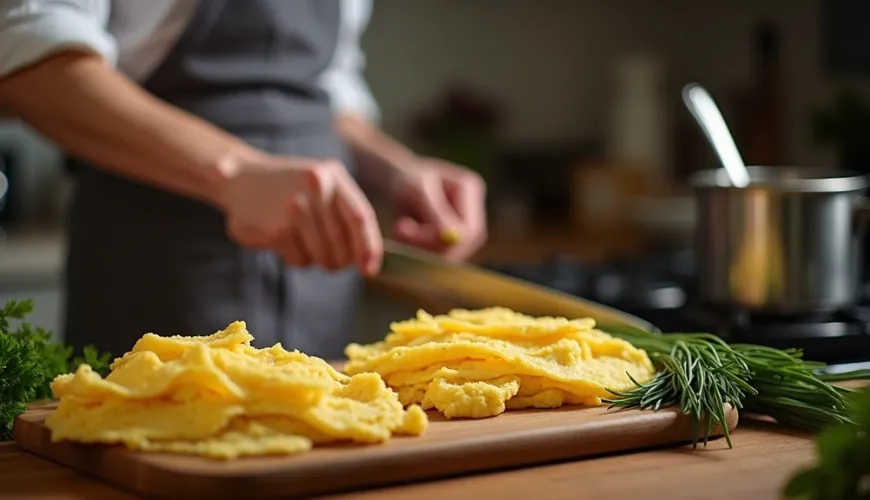
Discover the magic of frittata noodles in traditional soup

Fritata Noodles - A Traditional Delicacy That Shouldn't Be Missing in Soup
Sometimes, it takes just a little to turn an ordinary soup into something extraordinary. Fritata noodles – simple yet flavor-rich noodles made from egg omelet – have the ability to transform a regular broth into a meal you’ll remember. They are part of traditional Central European cuisine, especially Austrian and Bavarian, but they also have a firm place in Czech households.
Although they appear less frequently than classic pasta in our kitchens, fritata noodles are gaining popularity. Why? Because they are easy to prepare, tasty, and versatile. And perhaps most importantly – they can be made with ingredients that almost everyone has at home.
What Actually Are Fritata Noodles?
Fritata noodles (sometimes referred to as "frittaten" or "pancake noodles") are thin strips of fried egg omelet, sliced into noodles, typically added to clear broths. You can imagine them as an unsweetened pancake cut into thin strips.
In German-speaking countries, they are a staple of the traditional cuisine – for example, in Austria, they are called "Frittatensuppe" and are a popular starter not only in homes but also in restaurants. In the Czech Republic, they are less common, yet they are winning the hearts of those who appreciate a homemade, diligently prepared soup.
Although they might seem complicated at first glance, the recipe for fritata noodles is very simple. Anyone who has ever made pancakes or an omelet can handle it.
How to Prepare Fritata Noodles Step by Step
The basic preparation of fritata noodles involves making a thin batter, which is fried like a very thin omelet or pancake without sugar. After cooling, it is rolled and sliced into fine strips. The result? Soft, gently egg-flavored noodles that absorb the taste of the broth wonderfully.
Necessary Ingredients:
- 2 eggs
- 60 ml milk (or water)
- 1 tablespoon plain flour
- a pinch of salt
- butter or oil for frying
Procedure:
- In a bowl, whisk the eggs with milk, add a pinch of salt, and stir in the flour. The resulting batter should be smooth and runny, similar to pancake batter.
- Heat a little butter or oil in a non-stick pan (preferably with a diameter of about 20–24 cm).
- Pour a thin layer of batter and fry until golden on both sides. The omelet should be very thin, ideally 1–2 mm.
- Let the omelet cool, then roll it up and cut into thin noodles with a sharp knife. They are ready to be served in soup.
This basic version is quick and simple, but if you want to customize your soup, you can enrich the batter with chopped herbs (e.g., parsley, chive, or thyme), a pinch of nutmeg, or grated Parmesan.
Using Fritata Noodles in the Kitchen
Fritata noodles are most commonly used as an addition to clear soups – chicken, beef, or vegetable broth. Their advantage is that they do not overcook, do not cloud the broth, and due to their delicate taste, they allow the strong broth to shine.
An example from everyday life? A grandmother in a South Moravian village always makes fritata noodles when expecting guests for Sunday lunch. She believes that nothing smells like home as much as beef broth with homemade noodles. And since she doesn't like store-bought pasta, she opts for the classic – omelet noodles, which always receive admiration. No wonder. Their delicacy and taste are appreciated not only by children but also by seniors, for whom they are easily digestible.
In larger cities, fritata noodles also appear on the menu of modern bistros or traditional Austrian restaurants. Combined with quality broth and fresh herbs, they create a comforting meal that satisfies and soothes.
Interesting Facts and Tips for Perfect Results
You might be surprised to learn that fritata noodles are not only tasty but also quite healthy – they contain proteins from eggs, minimal fat, and no added sugar. If you have a gluten-free diet, you can replace the flour with a gluten-free variant or omit it entirely. In that case, they will resemble omelets more than pancakes, but they will still be delicious.
An interesting trick used by experienced chefs? Let the omelets cool completely before slicing or briefly place them in the refrigerator. They will roll and slice more easily into really thin noodles.
And if you have any leftover noodles, you can store them in the fridge and use them in soup the next day. Or quickly fry them in a pan with a little butter, add herbs, and you have an unconventional but very tasty side dish.
Why Give Fritata Noodles a Chance?
At a time when most people rely on semi-finished products or store-bought pasta, fritata noodles represent a return to honest cooking. Their charm lies in simplicity – with three basic ingredients, you create something delicious and visually appealing. Moreover, it is a way to use leftover eggs or milk without having to plan a big cooking session.
Although they appear only marginally in Czech cookbooks for now, they are worth trying. They are ideal not only as a soup addition but also as a way to bring a new dimension to traditional dishes. And if you’re looking for a way to make soup more appealing to children who might not be interested at first glance – trust that colorful omelet noodles might be what convinces them to finish the whole bowl.
As the famous Austrian chef Roland Trettl says: “Perfection lies in simplicity, which cannot be replaced by anything.” And fritata noodles are proof of that.
So next time you make broth, try choosing this traditional variant instead of classic noodles. Your guests and family will appreciate the extra effort – and yet, it's just a matter of minutes.
Fritata noodles might not be a novelty from modern culinary trends, but their return to our menus is proof that honest home cooking still has much to offer. There is incredible power in simplicity.

